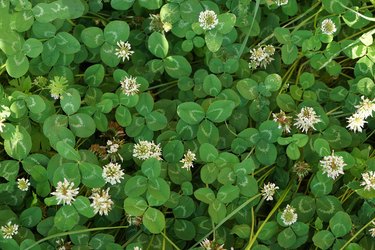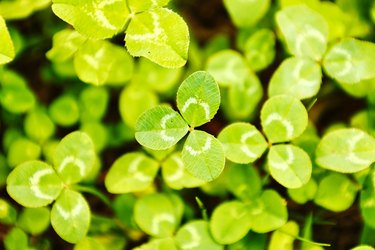
Clover includes a wide variety of plants in several different plant families, including rubiaceae, trifolium and melilotus. Farmers use clover for forage, hay and soil-erosion control. The legume fixes available nitrogen, making it useful as an improvement to the soil as a cover crop for interplanting or crop rotation. Popular clover crops include red, white and sweet clovers. The elimination of weeds through herbicide application is necessary to prevent yield losses. Weeds compete with clover for sunlight, nutrients and water. Correctly applying the appropriate herbicide controls weeds while limiting damage to the clover crop.
Benefin Preemergent Weed Control
Video of the Day
Benefin, known by the trade names of balan and balfin, provides preemergent weed control when applied to turfs, alfalfa, lettuce and clover crops. Preemergent herbicides target weed seeds and inhibit germination. Application occurs before or after planting clover. Incorporation into the soil within eight hours is recommended. Controlled weeds include annual bluegrass, sandbur, carpetweed and ryegrass. The herbicide is not effective against already established weeds. Benefin will not react with atrazine residues in the soil.
Video of the Day
EPTC Postemergent Herbicide
EPTC, commercially labeled as eptam, controls annual grasses, perennial weeds and broadleaf weeds in field crops, including clover. Available in both granular and liquid formulations, EPTC is a postemergent herbicide. Postemergent herbicides fatally damage established weeds. Farmers apply EPTC by incorporation into the soil, introduction through irrigation water and subsurface injection. It is important to note that eptam should not be applied after the use of atrazine. Residue levels may result in a synergistic reaction and cause clover crop injury.
Slow Acting 2,4-DB

2,4-DB, or butyrac, controls broadleaf weeds in clover crops when formulated as an amine salt. While safe for use on clover, only 2 percent of butyrac usage is on clover crops. Clover grows quickly, but butyrac usage requires a 60-day interval between spraying and harvest. Most producers prefer clover for foliage before it flowers. In the majority of applications, the clover has already reached the flowering stage by the time the waiting period is over.
Preemergent and Postemergent Prowl
Prowl applications are safe for clover in both preemergent and postemergent applications. The usage of Prowl on clover limits the usage of the clover crop to seed production, turf and cover crop. Clover treated with Prowl cannot be used for forage or hay. The product supplemental label warns that "no portion of the treated field, including the seed, seed screenings, hay forage or stubble, may be used for human or animal feed."
Sethoxydim Postemergent Herbicide
Commercially known as Vantage and Poast, sethoxydim controls annual and perennial grasses in clover when applied as a postemergent herbicide treatment. Broadleaf plants and sedges tolerate application and require an alternative herbicide treatment for control. Application methods include both ground and aerial spraying.
Postemergent Clethodim Control

Clethodim, known by the brand names Envoy, Volunteer, Prism and Select, provides postemergent control of annual and perennial grasses in broadleaf crops, including clover. Farmers apply the liquid by spraying through ground equipment. This product should be applied to weed grasses less than 6 inches tall for the best results. Farmers may mix clethodim with 2,4-DB for broadleaf weed control.
- University of Florida Extension: Weed Management In Clover
- Oregon State University Extension: Pest Management Handbooks – Preplant
- University of California, Fresno Extension: Getting the Most Out of Butyrac 200 (2,4-DB Amine) and Buctril (Bromoxynil) Applications
- Oregon State University: Prowl Herbicide In Alfalfa and Red Clover Seed Production
- North Carolina State University Extension: Segment (Sethoxydim) Herbicide Information Factsheets
- Clemson University: Weed Control In Forage Legumes
- Cornell University Cooperative Extension; Sethoxydim (Poast) Chemical Profile; March 1985
- Penn State College of Agricultural Sciences: Table 2.6-4 Herbicides
- Cornell University Cooperative Extension; Clethodim (Select) Herbicide Profile; January 1992
- Oregon State University; Herbicides for Weed Control in Clover; Corey V. Ransom, et al.; 1998